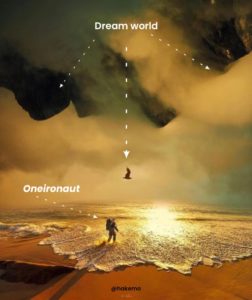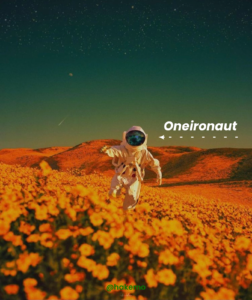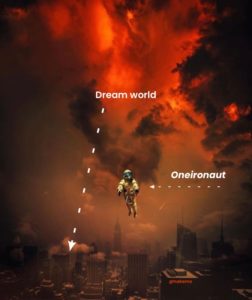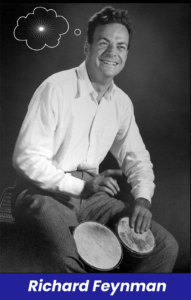Are you an Oneironaut?
You probably never heard this word before, but if you’re like me, you’re fascinated by dreams. And if you’ve taken steps to dig deeper into your own dream world, you might actually be an oneironaut.
Definition of Oneironaut
A person who explores dream worlds, usually associated with lucid dreaming. An oneironaut is one who consciously and deliberately explores his or her own dreams.
Origin of Oneironaut
 Oneironaut is a combination of the Greek word for dream (oneiro) and the Greek word for sailor (naut, as in nautical), also voyager or explorer.
Oneironaut is a combination of the Greek word for dream (oneiro) and the Greek word for sailor (naut, as in nautical), also voyager or explorer.
So, Oneironaut means dream explorer.
Other words sharing the prefix ‘oneiro’ include oneirogen (a dream-inducing drug) and oneiroscopy (dream observation or interpretation). And other words sharing the suffix ‘naut’ include astronaut, juggernaut, and psychonaut (a person who explores his or her own psyche – often with the aid of psychedelic drugs).
So, an oneironaut is an adventurer who explores and discovers the wonders of the dream world within. Just as a psychonaut explores the mysterious dimensionality of the mind, so does the oneironaut – only without the use of psychedelics. The oneironaut’s drug of choice is sleep (and maybe a little galantamine).
Everybody has the capacity to become an oneironaut, all it takes is one key ingredient — awareness.
Because everyone dreams every night, and we all have the capacity to be aware in the present moment, we all have the capacity to be aware during dreams and explore them consciously.
And this is why Mindfulness-Based Lucid Dreaming is the perfect path to becoming a bold, skilled oneironaut. Mindfulness develops our capacity to be aware in the present moment, and lucid dreaming cultivates our ability to do so during dreams.
Why you should become an Oneironaut
Quite often while awake, we turn attention inward and dwell within our own mental spaces. We take time to think things through. We plan, visualize, picture, envision, get creative, and solve problems, all in our own personal “dream” worlds. (Remember, technically, we dream while awake too).
These are incredibly useful skills to have! Mental preparation… prepares us for life’s challenges. When we manage our expectations properly, we are never disappointed. Planning to do something nice for someone else, improves our relationship with that person. When we consider risks, we are more likely to avoid danger; maybe even lethal danger… and the list goes on.
So, why should you learn lucid dreaming and embark on an oneironaut’s journey? As I’ll explain below, lucid dreaming is more than just self-entertainment. Yes, it’s fun and incredibly interesting, but WHY BOTHER?
The answer is the same as why you’d bother thinking things through while awake – because it’s useful. Allow me to elaborate here with a few reasons why lucid dreaming is useful:
Lucid dreaming is advanced thinking
Now, although thinking and visualizing while awake are helpful, the imagery resolution is pretty low. Trying to visualize while awake is like trying to project a movie onto a screen when all the lights are on in the theater.
The daydream picture quality is just nothing compared to the high-res experiences we have in sleep-dreams. Most likely, no matter hard you concentrate, you cannot fully picture, exactly what you try to picture while you’re awake (unless you’re Nikola Tesla).
But during sleep-dreams, ‘the lights are out’ so the picture is free to shine through in bright, vivid detail — astonishing detail. In no other state but the lucid dream state can you visualize in truly optimal high-res, and full, multi-sensory detail. This goes for more than just visual imagery, it goes for sound – if you’re a musician or singer, for instance, in a lucid dream you could compose new music and hear it played beautifully, in the highest audio quality, right then and there in the dream.
Oneironauts are highly creative
On that note, you’ve had songs get ‘stuck in your head’ before, right? You can kind of ‘hear’ the song playing in your head… well in lucid dreams, you hear the song actually playing and it can sound like full concert production quality. And again, you can create and listen to your own music in that state of consciousness
Whether you’re deliberately attempting to create art or music or you’re just seeing or listening to it in lucid dreams, you are still the one creating what you’re perceiving. It’s your dream so you are producing all that you experience. This is a profound, transformative benefit to being an oneironaut. Because you can change the reality you experience, this can be especially therapeutic if you have nightmares.
Lucid dreaming can even be used to treat nightmares. Once you realize you’re dreaming, if you’ve developed the skillset, you can effectively transform the nightmare into something less disturbing, even cathartic and therapeutic.
Famous Oneironauts
Nikola Tesla was a highly skilled lucid dreamer
Along with countless innovations and inventions, Nikola Tesla also developed an incredible mental skillset – visualization and waking-lucid dreaming. He was able to mentally envision complex machinery and even run experiments entirely in his mind.
This is essentially the true value of lucid dreaming; creating high-resolution mental models and attempting to solve high-level, complex problems at no cost and with no risk… Typically this is practiced during the lucid dream state, but Tesla was able to do it while AWAKE. Check out this quote from Nikola Tesla’s biography:
“Every night, (and sometimes during the day), when alone, I would start on my journeys – see new places, cities, and countries; live there, meet people and make friendships and acquaintances and, however unbelievable, it is a fact that they were just as dear to me as those in actual life, and not a bit less intense in their manifestations. This I did constantly until I was about seventeen when my thoughts turned seriously to invention.
Then I observed to my delight that I could visualize with the greatest facility. I needed no models, drawings, or experiments. I could picture them all as real in my mind.
My method is different. I do not rush into actual work. When I get an idea I start at once building it up in my imagination. I change the construction, make improvements and operate the device in my mind.
… In this way, I am able to rapidly develop and perfect a conception without touching anything. When I have gone so far as to embody in the invention every possible improvement I can think of and see no fault anywhere, I put into concrete form this final product of my brain.”
Pretty cool, huh?
Richard Feynman’s dream experiments
Feynman leveraged his intellectual curiosity to help him attain and maintain lucidity during his dreams. He explored often and made many interesting discoveries in his lucid dreams, as a true oneironaut should. Naturally, he found some entertainment value in the practice as well…
should. Naturally, he found some entertainment value in the practice as well…
Here’s an excerpt from a dream report from his book “Surely You’re Joking Mr. Feynman” in which he actively sought out the company of three beautiful women on a train.
“Well, I began to get excited, intellectually as well as sexually, saying things like, “Wow! It’s working!” and I woke up.”
He even overcame his fear of sleep paralysis by means of reason and logic. He writes:
“During the time of making observations in my dreams, the process of waking up was a rather fearful one. As you’re beginning to wake up there’s a moment when you feel rigid and tied down, or underneath many layers of cotton batting.
It’s hard to explain, but there’s a moment when you get the feeling you can’t get out; you’re not sure you can wake up. So I would have to tell myself–after I was awake–that that’s ridiculous.
There’s no disease I know of where a person falls asleep naturally and can’t wake up. You can always wake up. And after talking to myself many times like that, I became less and less afraid, and in fact, I found the process of waking up rather thrilling–something like a roller coaster: After a while, you’re not so scared, and you begin to enjoy it a little bit.”
He realized that despite the intensity and utter strangeness of the sleep paralysis experience, it was always short-lived and never posed a legitimate threat. This is essentially what I advise in the guided course in Mind Awake — don’t let fear consume you, embrace the moment, even let yourself be entertained by it, knowing it’ll soon pass, just as all moments do.
Christopher Nolan’s lucid dream fascinations
Nolan experimented with the Wake-Back-to-Bed method for lucid dreaming unwittingly. He would stay up late, go eat breakfast, and then go back to bed, enthusiastic about the unique opportunity he then had to explore his dreams consciously. Here’s a quote from an interview he did about his sci-fi thriller Inception:
“[I]n that slightly weird, discombobulated sleep I discovered that you can have active dreams and that when you realize you are dreaming, you can control the dream. I thought to myself that was really amazing. I remember having a dream and saying to myself, “Okay, there’s a bunch of books on the shelf.
If I pull a book off the shelf and look at it, can I read the words in the book?” And I could, because your brain is making up the words in the book. Or you could be walking on a beach in your dream and pick up a handful of sand and you’d be looking at all the grains and thinking, “Well, my brain is putting all the millions of grains in this handful of sand.”
Aristotle
“He argued that if someone were to place his finger directly in front of your eyes without your observing his doing it, the resulting double image would cause you to believe that you were seeing two fingers. If on the other hand, you were to observe his finger as it nears your eye, you would not be misled by your double vision into believing that there actually were two fingers.
“Exactly so it is in the states of sleep,” Aristotle continued, “if the sleeper perceives that he is asleep, and is conscious of the sleeping state during which the perception comes before his mind, it presents itself still, but something within him speaks to this effect: ‘The image of Koriskos presents itself, but the real Koriskos is not present’ ”
– LaBerge S. (1988) Lucid Dreaming in Western Literature. In: Gackenbach J., LaBerge S. (eds) Conscious Mind, Sleeping Brain. Springer, Boston, MA. https://doi.org/10.1007/978-1-4757-0423-5_2
Aristotle is referring to dream imagery and awareness (lucidity) during the dream state.
How to become an Oneironaut
Becoming an oneironaut means adopting an adventurer’s mentality. Be curious, stay enthusiastic, expect the unexpected, and be ready for challenges along the way. Here are some tips for how to become an oneironaut:
Use a dream journal regularly
Dream journaling improves dream recall. Setting the intention to remember and write dreams down triggers your prospective memory, making it easier to recall dreams in the morning. If you write dreams down for 3 or 4 days in a row, by day 5, you’ll be amazed at how much more dream content you’re remembering. You will make progress naturally by writing in your dream journal every morning.
This also cultivates familiarity with dream content, locations, characters, themes, activities, etc. The more familiar you are with your dreams, the better you’ll be at exploring them.
Use your dream journal entries to help map your territory.
As an oneironaut, you’ll need a map to help you chart and explore your dream territory. Many dreams are just utterly bizarre and unrelatable to waking life.
These sorts of dreams can leave oneironauts feeling perplexed and lost in their practice. But by recording the dream, and sticking to the program, one can reorient, get back on track and keep moving forward. The sentiment becomes: “Ok wow, that dream was weird… but so what?”
It’s natural for dreams to be strange. The journaling process will help you accept and embrace that fact and simply move on to the next night of practice!
In order to get lucid and consciously explore your dreams, all you need to do is recognize the signs that you are dreaming. And your dream journal (your map) will be full of those signs. So, the more familiar you get with your map, the more prepared you’ll be to get lucid.
Explore dreams often and enthusiastically.
Becoming an oneironaut has a sort of momentum to it. It’s like getting in shape, or ‘getting the hang of it’. Not only will you feel a sense of progress when you practice lucid dreaming, but you’ll feel a sense of growth. Though it can be difficult to identify the gains you’ll make as a lucid dreamer, they are no less real and no less beneficial. So keep in mind, there is no rush because you will dream every night of your life, for your whole life.
Yes, if you don’t use it you’ll lose it… but only temporarily — you can always pick it up again when you’re ready to commit!
Explore dreams with the proper guidance.
Though you are the only one who can explore YOUR dreams, you are by no means the first person to explore dreams. Over centuries and millennia, people have developed theories and practices to help guide you on your journey into your dream space. Of all the methodologies and recommendations out there, I truly believe taking a mindfulness-based approach is the smartest bet.
You can get a quick and easy introduction to oneironautics and lucid dreaming with this oneironaut pdf.
Check out the Mindfulness-Based Lucid Dreaming course I’ve developed (and am always improving upon) here. Enjoy your many adventures and please feel free to get in touch to learn more or discuss lucid dreaming.




1 thought on “Are You an Oneironaut?”
How contact oneioronut scientists, which for being study subject of my daily dreams